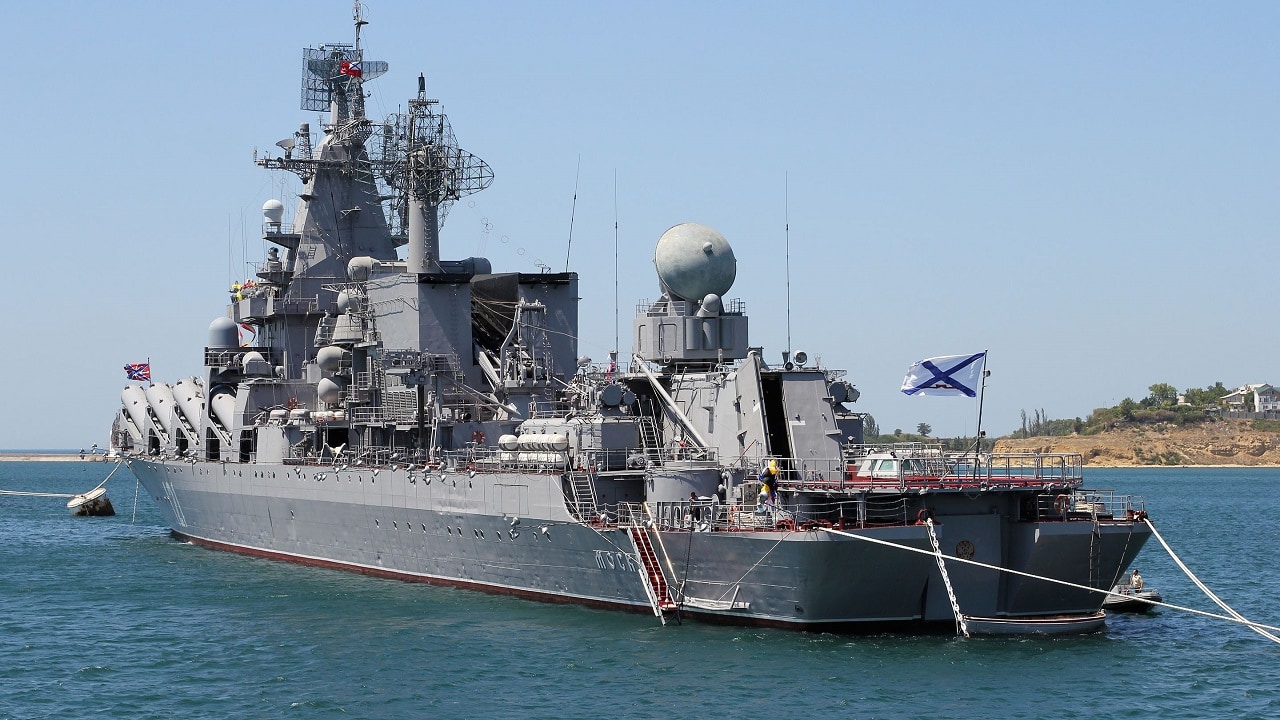Early reports indicate that the Russian cruiser Moskva, flagship of the Black Sea Fleet, has been severely damaged or possibly sunk (NOTE: most reports at present indicate it was seriously damaged at the time of this writing) after a fire and explosion. Ukrainian authorities announced yesterday that the ship had been struck by two Neptune anti-ship missiles, and Russian officials have confirmed that the ship suffered a fire and that the crew has been evacuated. One report indicated that the Moskva air defense system was distracted by a Ukrainian TB2 drone, facilitating the missile strike. According to this report, Moskva then rolled onto her side. If the loss of the ship is confirmed, she will be the largest warship destroyed in combat since the sinking of the Argentinian cruiser General Belgrano (the former USS Phoenix) in the Falklands War in 1982. However, the full details of the attack may not be known for several days.
Moskva, one of three Slava class cruisers, was prominently displayed by the Russian navy in the run-up to the war. She and her two sisters (Marshal Ustinov, and Varyag) deployed to the Mediterranean in a show of force presumably intended to intimidate NATO, after which Moskva returned to the Black Sea.
Moskva displaces over 11,000 tons at full load and can make 32 knots at top speed. She and her two sisters were completed in 1982, 1986, and 1989 respectively at Mykolaiv shipyard in what is now Ukraine. Mykolaiv has recently seen heavy fighting as Ukrainian forces stopped a Russian mechanized advance along the coast of the Black Sea.
The Slava-Class: A History
The Slavas were initially constructed to attack US carrier battle groups, carrying a visually striking set of massive missile canisters on each flank of the superstructure. These canisters carry the P-500 Bazalt missile which, with a range of some 300 miles, could be coordinated and directed by independent platforms (such as a maritime surveillance aircraft). Salvos of the missiles could communicate with one another to detect and attack their targets. However, these missiles have not been upgraded to attack land targets and there is no indication that Moskva has fired missiles against Ukrainian targets.
Moskva’s defensive armament includes S-300 “Grumble” surface-to-air missiles with a range of about sixty miles, anti-submarine mortars and torpedoes, and Close-In Weapon Systems (CIWS) designed to protect from missile attacks.
Her most important weapon against Ukraine might have been the twin 130mm gun, capable of firing in excess of 10 rounds per minute to a range of more than 20 kilometers. This fire could devastate land-based installations, whether in preparation for an amphibious assault or independently.
Moskva’s War Record in Ukraine
Moskva most notable participation in the Russian invasion came at the Battle of Snake Island, one of the most famous events of the war. She and another Russian warship began to bombard the island on February 24, then sent a message to the Ukrainian defenders demanding surrender. One Ukrainian soldier immortalized the moment by replying “Russian warship, go f*ck yourself!” The Ukrainian contingent was captured after a brief bombardment but later released in a prisoner exchange.
What Really Happened to the Moskva?
We will need more detail about the Ukrainian attack in order to come to any useful conclusions about what this means for the future of naval warfare. There seems to be little question that UAVs such as the TB2 will have an important role in the future of maritime strike, and the ways in which Ukrainians may have used the UAV to distract Moskva’s crew from the main attack will certainly deserve additional study.
It also bears mention that many analysts of naval affairs have argued for a long time that large, expensive surface warships like Moskva represent more of a vulnerable liability than a lethal asset. On the other hand, some will argue that Moskva is the exception that proves the rule; major warships are vulnerable when they are poorly defended and not equipped with the most modern defensive weaponry.
The apparent attack of Moskva represents a humiliating defeat for the Russian navy, which had already suffered a catastrophe after losing an Alligator class amphibious assault ship to fire last month.
A significant Russian asset, Moskva made only a trivial military contribution to the war while producing two of the greatest Ukrainian propaganda victories of the conflict.
Now a 1945 Contributing Editor, Dr. Robert Farley is a Senior Lecturer at the Patterson School at the University of Kentucky. Dr. Farley is the author of Grounded: The Case for Abolishing the United States Air Force (University Press of Kentucky, 2014), the Battleship Book (Wildside, 2016), and Patents for Power: Intellectual Property Law and the Diffusion of Military Technology (University of Chicago, 2020).

